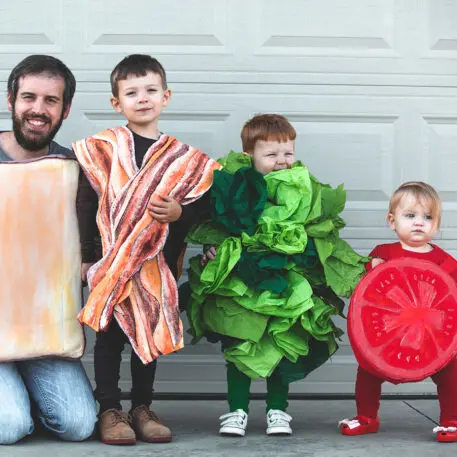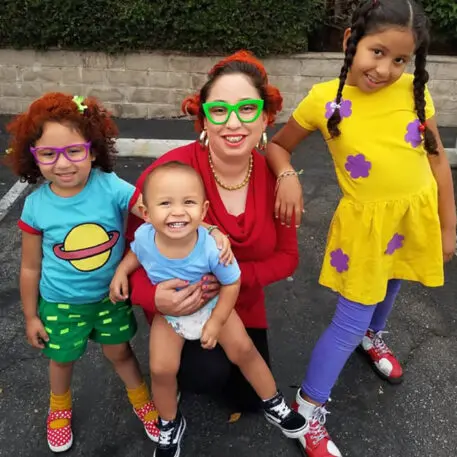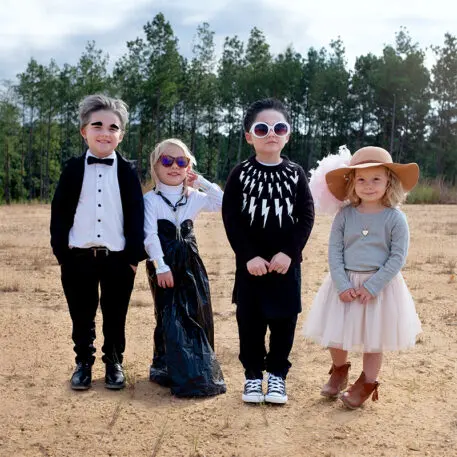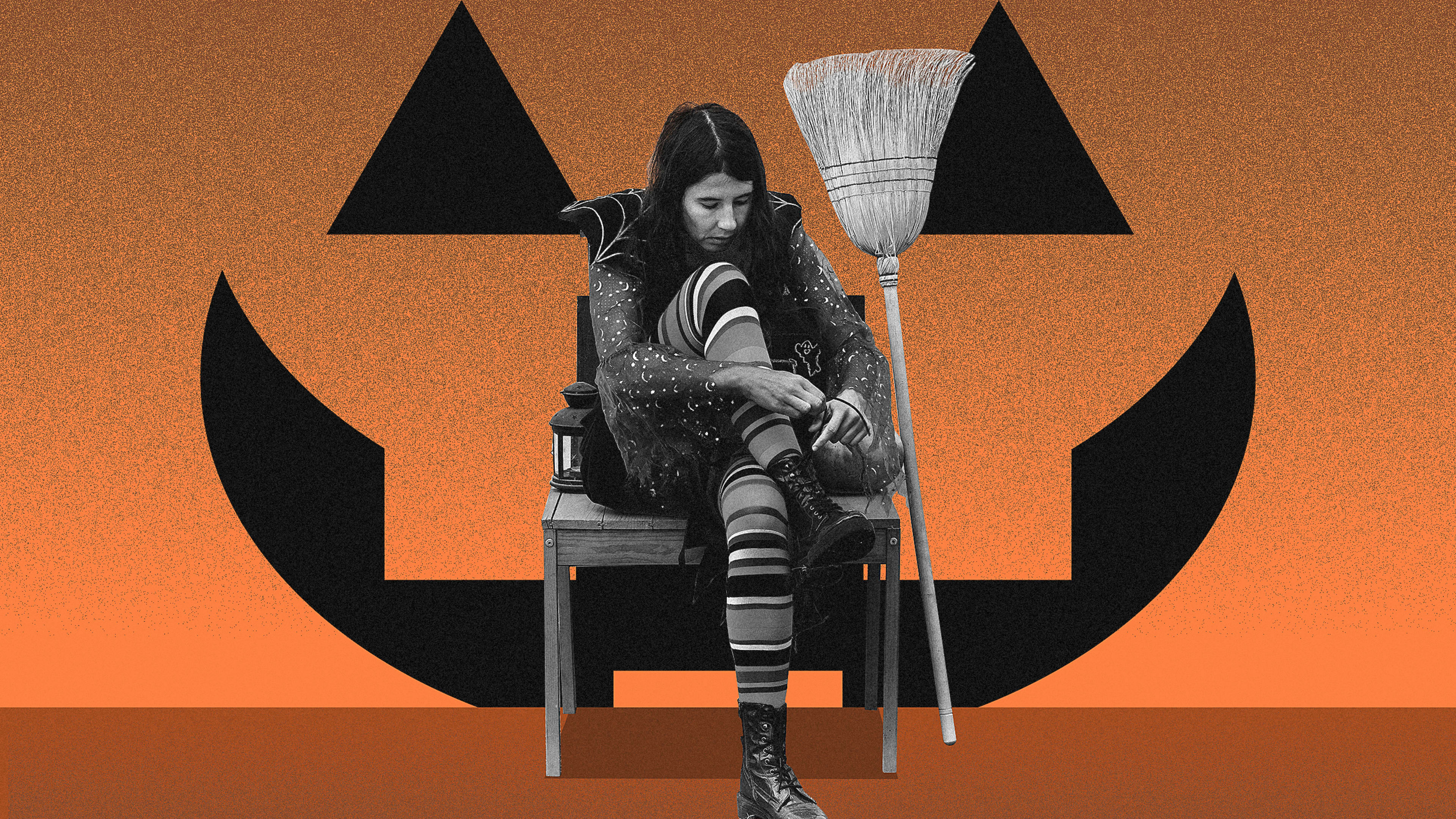It’s about time we got spooked about the environmental impact of Halloween.
American consumers are expected to spend $3.32 billion on Halloween costumes this year. Most of these will be cheap, disposable costumes sold by retailers like Spirit Halloween and Walmart. Around 83% of materials used to make these costumes is derived from plastic. And many will be thrown out on November 1. In the U.K., one study found that 7 million costumes are thrown out each year—potentially the equivalent of 83 million plastic bottles. In the U.S. which has five times the population and where Halloween is a more popular holiday, that figure will be significantly higher.
The good news is that you can still have a fun-filled Halloween without adding to this waste. In fact, you can take a page from Halloweens of the past, when disposable costumes weren’t the norm. “When I was growing up, we made our costumes or bought them from thrift stores,” says Aja Barber, author of Consumed: The Need for Collective Change. “One year, I wanted to be a present, so my mom and I went door-to-door at grocery stores asking for an enormous box. I still have fond memories of that experience we had together.”
I get the appeal of a premade costume. For people like me who are creatively challenged with no crafting skills to speak of, the idea of making a costume from scratch sounds daunting. But fortunately, help has arrived. Four years ago, Tiffany Beveridge, content director at kid’s clothing startup Primary, launched a free Halloween costume concierge to help people make their own costumes from clothes they already own (and that can be transformed back into regular clothes after the holiday). The company has a helpline and email address where people can ask for guidance about how to create costumes—for both adults and kids—from scratch.
Here’s a step-by-step guide to creating a more eco-friendly costume this year.

Give yourself time
Part of the appeal of the ready-made costume is that you can snag one at the last minute. But Beveridge says making your own costume isn’t as time consuming as it seems. Many people can make an impressive costume in only half an hour; more advanced costumes can take a day. However, it does take some planning to figure out what supplies you need. And more broadly, it’s worth reconceptualizing the entire process. You should think about it as a fun, relaxing project, which can be far more enjoyable than just another shopping excursion. “You can’t beat the sense of accomplishment you feel when you’ve managed to create your costume with your own hands,” Beveridge says.
It’s also important to remember that perfection isn’t the goal. Beveridge says the point is to have a good time and approximate the person or object you’re trying to create. And remember, store-bought costumes aren’t all that great either. Many are tacky and don’t really look like the character they’re trying to represent.

The sky is the limit
Most retailers stock up on a set of popular costumes, which is why in any given year you’ll see so many witches and Spider-Men. Beveridge says another benefit of making your own costume is that it can be one of a kind.
You can have a fun brainstorm to come up with ideas about how you might want to express yourself: Do you want to go spooky or funny? Do you want to go as something topical (like a Pfizer vaccine) or do something classic (like Scooby-Doo)? If you have friends and family members who also want to dress up, you could have fun thinking up a group costume. Were you a fan of Between Two Ferns? You could go as Zach Galifianakis and have two of your friends go as plants. Or there are more conceptual group costumes. For instance, you and your friends could dress entirely in green and be Gangrene.
If you’re searching for inspiration, there are many places to look. You can search for DIY Halloween Costumes on Pinterest and Instagram. Primary also has a catalog of DIY costumes on its website.

Focus on reducing waste
Even when creating your own costume, it’s possible to generate waste if you cut up perfectly good clothes or modify them in a way that you can’t reuse them. To avoid this, be strategic about how you design your outfit. Beveridge recommends using a monochromatic outfit as a base; for instance, a T-shirt and leggings in a single color, which you can then adorn. If you don’t happen to have these pieces in your closet, you can buy them and wear them again in the future.
Rather than permanently altering these clothes, use double-sided fabric tape to affix pieces on top, like colorful felt, cardboard, pompons, or tulle. If you and your crew want to spend Halloween as a pack of crayons, you could dress in different primary colors, then use double-sided tape to add the word “Crayola” in black paper. To perfect the look, wear pointy party hats or make cones out of cardboard. If you wanted to be a family of condiments, you could dress in red, yellow, and green, then print out the massive logos for Heinz ketchup, mustard, and relish on a color printer, which you can affix to the T-shirt. You get the idea.

If you just can’t
If you simply can’t bring yourself to make your own costume, don’t despair. “There are so many approaches that don’t rely on just going to the store,” says Melissa Breyer, editorial director of the sustainability website Treehugger. “And you can still have a great holiday with fun costumes.” She recommends scanning secondhand sites like Facebook Marketplace or your local Buy Nothing group. Alternatively, look for a secondhand costume or a retro outfit at your local thrift store. Finally, if you’re really into making an impression, you can rent a costume from a site like Halloween Costumes, rather than buying one.
Remember, every little bit helps
Given the immensity of the waste produced every Halloween, it might feel like trying to be more sustainable isn’t worth your time and energy. “There is an entire Halloween industrial complex that is pushing their marketing at you,” Breyer says. “It takes resistance to go against it.”
But it’s worth the effort, Breyer and Barber say. For one thing, you’re making a statement within your community that it’s possible—and even fun—to avoid cheap, disposable costumes. “You might not make a difference as a single person, but when hundreds, then thousands, then millions of people push back against the machine of overconsumption, it can make a difference,” says Barber.
Recognize your brand’s excellence by applying to this year’s Brands That Matter Awards before the early-rate deadline, May 3.
